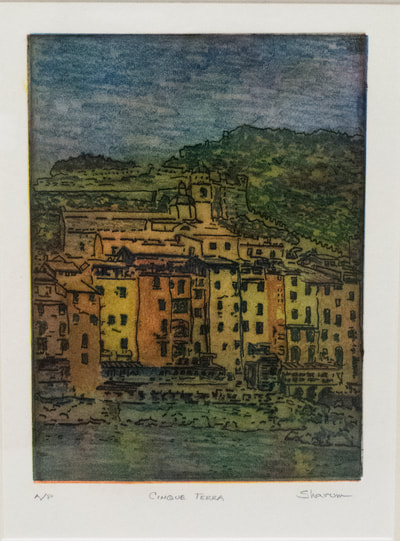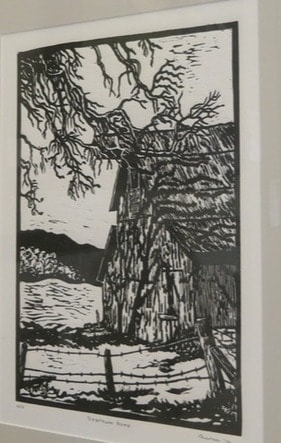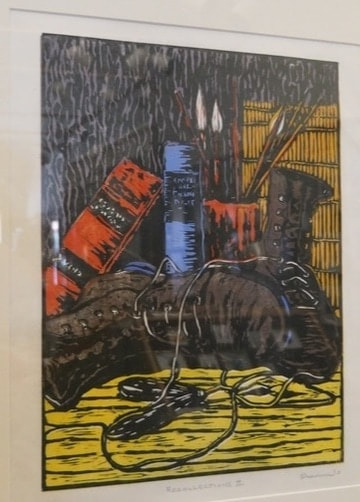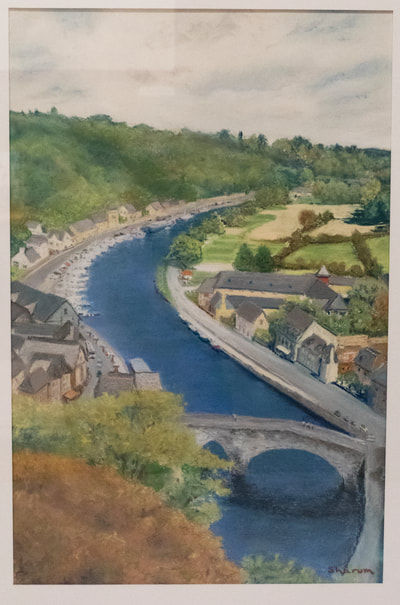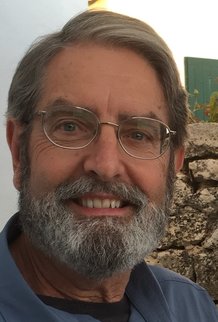
JOHN SHARUM
Printmaking
[email protected]
Originally from Michigan, John moved to Angels Camp in 2013 after living in Belgium, Texas and the Bay Area. Retired after thirty years in international business, he has pursued art in earnest since 2002. Using elements of line, color and value, John explores images of people and places that have moved him.
John considers his passion to be printmaking, using a variety of techniques such as etching, aquatint, linoleum and woodblock printing and monotype. He has studied under Belgian Artist, Rene Classens and Bay Area artists Luz Ruiz and Toru Sugita. His work has been shown in over twenty-five shows in California, winning numerous awards. John’s other mediums include pastel (studying with Tina Moore of Stockton), watercolor, acrylic and ceramics.
John’s earliest recollections of making art were of using clay, finger paints and crayons. Art period was his favorite time of school and he was encouraged by his early art teachers.
“The first sculptures I remember seeing were the snow horses my mother made in the front yard in Ann Arbor when I was four. With clay, one sees as much through touch as you do through your eyes when forming clay into your final vision. You also learn that the clay dictates as much as it is dictated to in developing a concept. There is an element of randomness in clay making, especially in the firing and glazing process, which is both maddening and liberating. This lack of control is also what allows serendipity to enter the creative process. I have worked in clay sporadically over the past 55 years.”
Finger painting shared this same tactile sensation. What John loved about the final image was the beautiful line quality—fluid, thick and thin, fast and slow—a record of the artist's every gesture. Today, John’s fascination with printmaking, particularly monotypes, has its roots in this same direct immediacy of finger painting. The process of mixing inks, applying them to the plate and then continuing by adding, subtracting, pushing, and pulling the ink combines these same elements of immediacy and direct "touch" but with an infinitely more complex set of variables. “Producing monotypes also encourages me to experiment with pure color and abstract compositions as well as representational images.”
Having a new box of Crayola crayons, was a magic moment. “I remember the first time I had a box with sixty-four colors. I couldn't decide which one to use first, but after a while your "palette" would evolve—all the short and broken crayons. I admit it. I was one of those that colored between the lines. In fact I loved the lines and the fields of color, eventually making my own lines and colored "prints". Later, I discovered graphite and pure tonal pictures. Today, my favorite medium is etching with aquatint combined on the same copper plate.”
The evolution of his print making began in 1973. “When living and working in Brussels, I took instructions at night from a print maker, Rene Classens. He taught me in heavily French accented English to etch, aquatint and print with his ever-present Gaulois cigarette dangling from his lip. He let me make the poster for the Artists December Open Studio and helped me sell my first print.” Returning to the States in 1974, it would be almost thirty years before John took up etching again. Life has a way of being daily.
Diablo Valley College rekindled John’s love of art. In 2002, John took figure drawing after 30 years away from any formal instruction. Drawing from life helped develop his ability to observe critically and begin to use the human figure in his other work. He explored new mediums, such as pastels and watercolors, in figure drawing, landscape and still-life. Acrylic painting classes followed and he began working on larger pieces as well as revisiting ceramics.
“Looking back, I see that art has always been a part of my life—not to the exclusion of other elements—but always in the background ready to be expressed. Now that I have the time to develop new skills and work on new themes I am realizing what a great joy it brings to me, and I hope in some way connects with those viewing my work, to bring understanding, amusement and another view of life.”
Printmaking
[email protected]
Originally from Michigan, John moved to Angels Camp in 2013 after living in Belgium, Texas and the Bay Area. Retired after thirty years in international business, he has pursued art in earnest since 2002. Using elements of line, color and value, John explores images of people and places that have moved him.
John considers his passion to be printmaking, using a variety of techniques such as etching, aquatint, linoleum and woodblock printing and monotype. He has studied under Belgian Artist, Rene Classens and Bay Area artists Luz Ruiz and Toru Sugita. His work has been shown in over twenty-five shows in California, winning numerous awards. John’s other mediums include pastel (studying with Tina Moore of Stockton), watercolor, acrylic and ceramics.
John’s earliest recollections of making art were of using clay, finger paints and crayons. Art period was his favorite time of school and he was encouraged by his early art teachers.
“The first sculptures I remember seeing were the snow horses my mother made in the front yard in Ann Arbor when I was four. With clay, one sees as much through touch as you do through your eyes when forming clay into your final vision. You also learn that the clay dictates as much as it is dictated to in developing a concept. There is an element of randomness in clay making, especially in the firing and glazing process, which is both maddening and liberating. This lack of control is also what allows serendipity to enter the creative process. I have worked in clay sporadically over the past 55 years.”
Finger painting shared this same tactile sensation. What John loved about the final image was the beautiful line quality—fluid, thick and thin, fast and slow—a record of the artist's every gesture. Today, John’s fascination with printmaking, particularly monotypes, has its roots in this same direct immediacy of finger painting. The process of mixing inks, applying them to the plate and then continuing by adding, subtracting, pushing, and pulling the ink combines these same elements of immediacy and direct "touch" but with an infinitely more complex set of variables. “Producing monotypes also encourages me to experiment with pure color and abstract compositions as well as representational images.”
Having a new box of Crayola crayons, was a magic moment. “I remember the first time I had a box with sixty-four colors. I couldn't decide which one to use first, but after a while your "palette" would evolve—all the short and broken crayons. I admit it. I was one of those that colored between the lines. In fact I loved the lines and the fields of color, eventually making my own lines and colored "prints". Later, I discovered graphite and pure tonal pictures. Today, my favorite medium is etching with aquatint combined on the same copper plate.”
The evolution of his print making began in 1973. “When living and working in Brussels, I took instructions at night from a print maker, Rene Classens. He taught me in heavily French accented English to etch, aquatint and print with his ever-present Gaulois cigarette dangling from his lip. He let me make the poster for the Artists December Open Studio and helped me sell my first print.” Returning to the States in 1974, it would be almost thirty years before John took up etching again. Life has a way of being daily.
Diablo Valley College rekindled John’s love of art. In 2002, John took figure drawing after 30 years away from any formal instruction. Drawing from life helped develop his ability to observe critically and begin to use the human figure in his other work. He explored new mediums, such as pastels and watercolors, in figure drawing, landscape and still-life. Acrylic painting classes followed and he began working on larger pieces as well as revisiting ceramics.
“Looking back, I see that art has always been a part of my life—not to the exclusion of other elements—but always in the background ready to be expressed. Now that I have the time to develop new skills and work on new themes I am realizing what a great joy it brings to me, and I hope in some way connects with those viewing my work, to bring understanding, amusement and another view of life.”
Please click on any image to enlarge.
